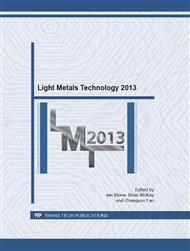p.69
p.77
p.82
p.87
p.92
p.97
p.102
p.107
p.112
A Model of Inclusion Behaviour in Liquid Aluminium
Abstract:
Inclusions in castings are particularly damaging as crack initiators, causing failure in service. It is therefore desirable to attempt to remove them prior to their entry into the casting. In this work the behaviour of inclusions was studied using a computer simulation to predict the movement of particles in flowing liquid metal. The computer simulation was created by a combination of Computational Fluid Dynamics (CFD) and Discrete Element Modelling (DEM), to try to predict the agglomeration characteristics of inclusions in liquid Al alloy in a launder system. The model was tailored to simulate dispersed particles in a fluid, where particle collisions with each other and with side walls are significant. The launder model had a wall or baffle placed along its length to investigate its effect on trapping inclusions, results from the model showing particle distribution.
Info:
Periodical:
Pages:
92-96
Citation:
Online since:
July 2013
Authors:
Keywords:
Price:
Сopyright:
© 2013 Trans Tech Publications Ltd. All Rights Reserved
Share:
Citation:


